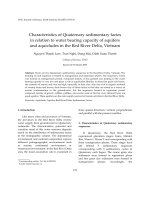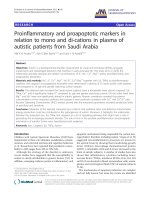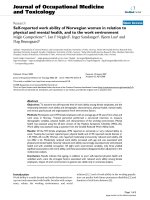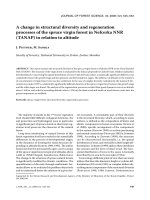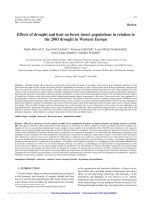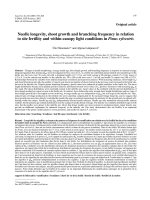star wars and the matrix in relation to the heros quest
Bạn đang xem bản rút gọn của tài liệu. Xem và tải ngay bản đầy đủ của tài liệu tại đây (39.84 KB, 2 trang )
"Nobody can be told exactly what the Matrix is; you have to see it for yourself."-Morpheus
"You must learn the ways of the Force, if you are to come with me to Alderaan."-Obi-Wan Kenobi
One character is played by one of Hollywood's strongest black actors; the other, by one of the
elder statesmen of film. But Morpheus and Obi-Wan Kenobi have a lot in common.
Those similarities take place in the larger context of two hit films, both of which have been huge
commercial successes that readily assume their places in popular culture. The Matrix and Star
Wars both resonate with audiences for specific reasons, in ways that similarly-themed movies with
less universal appeal do not.
The Matrix is not especially revolutionary in terms of presentation or storytelling, although the
special effects are great, but it is well written, slickly produced, and often devilishly clever. It also
has the same core element going for it that Star Wars did in 1977, it's a classic hero tale, the kind
that appeals to the aspiring adventurer in all of us.
The hero tale generally follows a very linear path, one whose route was handily traced by Joseph
Campbell in his classic book, The Hero with a Thousand Faces. Although Campbell is somewhat
outdated, his outlook was highly influenced by Freud, and his work tended to ignore rather than
discuss cultural distinctions in mythology His book is still valuable, both because it can tell us
about hero tales and because it has influenced their twentieth century retellings. Campbell, heavily
influenced George Lucas. Lucas apparently went through two drafts of the original Star Wars,
before revisiting Campbell's book for inspiration and guidance. It's likely that the makers of The
Matrix borrowed from him as well.
The Hero's Call and Departure
Both stories begin with calls to adventure for their heroes into situations those heroes never
expected; in fact, at the outset, neither Neo in The Matrix, nor Luke in Star Wars, has any idea
what's going on. Neo, wakes up to a message on his computer that says "follow the white rabbit".
Following the "white rabbit" leads him to a night club were he is approached by a mysterious,
PVC-clad woman who hints that the world is stranger and more dangerous than he knows. Luke
buys a couple of androids, one of which has a message that leads to the beginning of his
adventure. This device of the potential hero being either sought out or roped into peculiar
circumstances is a common one in heroic tales; frequently, the would-be hero is swept up into
something that he initially appears to have nothing to do with.
Almost every time, the hero initially resists, even though what's coming to him is what he's waited
for all his life. The Matrix even makes this explicit, in that, several times, Neo is told that he's
right to think that the world is not what it seems. However, something always happens to convince
the hero to change his mind. In The Matrix, Neo goes back to work and later finds himself edging
around a window ledge at the direction of a mysterious voice on a cell phone. Unable to take the
risk of plunging to his death, he instead allows himself to be taken into custody-where he finds a
powerful incentive to believe what Trinity and Morpheus have been telling him all along.
Similarly, Luke Skywalker initially refuses to go to Alderaan (and, it's implied, learn to be a Jedi)
until he has no choice, because his family has been killed and there's nothing left for him on
Tatooine.
The Initiation
A hero can't be a hero without an initiator. This is where the characters Trinity and Princess Leia
come in. The fact that both of these characters are female is not entirely coincidence. Since the
hero is almost always male and almost always young, the initiator is usually a damsel in distress
scenario. Leia is sending a distress message to Ben Kenobi that says, "Help me Obi-wan, you are
my only hope." This message intrigues young Luke. Likewise, Trinity approaches Neo with a
puzzling notion that the world isn't real. Shortly, we find that she is in of Neo's help.
Nor can a hero be a hero without a mentor. Morpheus in The Matrix and Kenobi in Star Wars
serve as teachers and guides, those who assist the hero in realizing their potential. Both movies
contain many references to vision, potential, and an expanded point of view. Luke takes his "first
step into a larger world," says Kenobi. Neo goes through a dramatic "re-birth" process. At the end
of having his atrophied body reconditioned, he wonders why his eyes hurt. "Because you've never
used them," Morpheus explains. This comment has several meanings, for Neo's first use of his
physical eyes comes with his understanding of the way the world really is. This sort of thing
happens often in mythology, and wisdom is often related to eyes or vision. In Norse myth, Odin
gives up one of his eyes in exchange for knowledge.
At the same time, the naive hero is cautioned not to accept everything he sees at face value. "What
is real?" Morpheus asks, while Kenobi warns, "Your eyes can deceive you; don't trust them." The
hero does well to take note of such cautions, for they are typically not bound by the same rules
everyone else is bound by. Neo learns to hack the Matrix, bending its enforced reality to his will,
and eventually comes to do it better than anyone else. By the end of the film, as Morpheus
predicts, he doesn't need to dodge bullets because he can simply stop them. Likewise, Luke is
able to accomplish a task at which others have failed; after two veteran pilots attempt to blow up
the Death Star and are shot down, Luke succeeds.
Now that the hero has acquired a quest and the knowledge, he needs to fulfill it. However, the
lesson of the hero-tale is that these things are useless if the hero doesn't believe in himself. In The
Matrix, the Oracle tells Neo that he isn't "The One," meaning the guy who's going to save
humanity from an existence as a bunch of deluded batteries. It's implied, though, that this is
because despite all evidence to the contrary, Neo doesn't believe it himself. As soon as he believes
he's "The One" . . . he is. This occurs when suddenly confronted by a seemingly undefeatable
agent, Neo takes a leap of faith and single handedly fights the agent rather than running. Similarly,
it takes Luke awhile to believe that the Force actually works, and initially he still uses his targeting
computer to aim at the Death Star's weak spot. Ultimately, though, he makes the same leap of
faith. And since this is a hero-tale, not a tragedy, they both succeed.
The Return
Neither of the heroes is without need of help though. In both stories they are aided by different
and distinct characters at critical and life threatening moments. Luke is on the verge of being shot
down by Darth Vader, just before he destroys the Death Star, when he is saved by a shot from Han
Solo in his Millennium Falcon. Neo is keep from being killed by an agent, when Trinity shots the
agent in the head.
At the end of both movies we are presented with events that signify the victory of the heroes. Luke
is given a medal at a grand ceremony for his help in defeating the Empire. Neo makes a phone call
to the machines with a threat that seemingly gives the machine a moment of pause.
Elements of Distinction
Of course, the two movies aren't identical. Although they share a theme regarding the dangers of
technology, The Matrix is by design much closer to our own world. Although Morpheus, Trinity,
Neo and the others are waging a war against A.I. run rampant, the creators of that AI were their
own ancestors. Star Wars is decidedly less complex, and doesn't bother to give us much
back-story; the Rebels are good and the Empire's bad, and that's just the way it is.
Also, while Star Wars has arguably influenced the way an entire generation thinks about morality,
ethics, and religion, The Matrix is far more explicit in terms of the kind of worldview it advocates.
The first thing anyone says to Neo in The Matrix is in a message that comes to him via his
computer: "Wake up, Neo." It so happens that the character is sleeping at the time, but this can
also be interpreted as a reference to the fact that Neo, like most people in the Matrix, is unaware
of the virtual reality that surrounds him. He needs to "wake up" to the real world and lose his
illusions. This idea is very similar in nature to Plato's allegory The Cave. In this allegory humans
are trapped in a cave and can see no light. They are unaware of the outside world and that there is
a better place for them than inside the cave. A few do escape and come in to the light. When they
do, they realize how much they have missed and cannot and will not return to the cave. Plenty of
similar references are sprinkled throughout the film, particularly during Morpheus's lectures on the
nature of the Matrix and of reality.
The Matrix is full of symbolic names like Neo, Trinity, and Cipher. For that matter, names in Star
Wars have meaning as well; "Skywalker" is an epithet for Loki, though Luke isn't nearly as
malicious as Loki is in Norse myth. The resemblance between "Darth Vader" and "Dark Father"
has been noted on several occasions as well. But these symbols are, by and large, less specific in
Star Wars than in The Matrix. Star Wars is a derivative of everything from Flash Gordon to the
films of Akira Kurosawa, The Matrix is influenced by sources as diverse as the Neuromancer to
Jean Baudrillard's Simulacra and Simulation to Buddhism and the Bible. Also, there is one more
important difference between the two films: Star Wars looks back, while The Matrix looks to the
future.


